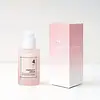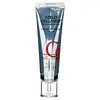What's inside
What's inside
 Key Ingredients
Key Ingredients

 Benefits
Benefits

 Concerns
Concerns

 Ingredients Side-by-side
Ingredients Side-by-side

Collagen Extract 73%
Skin ConditioningButylene Glycol
HumectantWater
Skin Conditioning1,2-Hexanediol
Skin ConditioningGlycerin
HumectantGlycereth-26
HumectantNiacinamide
SmoothingPEG-240/Hdi Copolymer Bis-Decyltetradeceth-20 Ether
StabilisingCaprylic/Capric Triglyceride
MaskingMethylpropanediol
SolventPolyglyceryl-3 Methylglucose Distearate
EmulsifyingHydroxyethyl Urea
HumectantCellulose Gum
Emulsion StabilisingDicaprylyl Ether
EmollientCaprylyl Methicone
Skin ConditioningGlyceryl Polymethacrylate
Glyceryl Stearate
EmollientRose Extract
Skin ConditioningWine Extract
AntioxidantSucrose
HumectantAdenosine
Skin ConditioningDisodium EDTA
Mineral Salts
Skin ConditioningSodium Hyaluronate
HumectantPotassium Laurate
EmulsifyingTocopherol
AntioxidantPotassium Hyaluronate
Skin ConditioningEthylhexylglycerin
Skin ConditioningHydrolyzed Elastin
EmollientHydrolyzed Keratin
HumectantHydrolyzed Silk
HumectantHyaluronic Acid
HumectantHydrolyzed Hyaluronic Acid
HumectantSodium Acetylated Hyaluronate
HumectantHydroxypropyltrimonium Hyaluronate
Sodium Hyaluronate Crosspolymer
HumectantDimethylsilanol Hyaluronate
HumectantCaprylyl Glycol
EmollientHydrogenated Lecithin
EmulsifyingSodium Phosphate
BufferingPalmitoyl Tripeptide-5
Skin ConditioningAcetyl Hexapeptide-8
HumectantOligopeptide-3
Skin ConditioningParfum
MaskingCollagen Extract 73%, Butylene Glycol, Water, 1,2-Hexanediol, Glycerin, Glycereth-26, Niacinamide, PEG-240/Hdi Copolymer Bis-Decyltetradeceth-20 Ether, Caprylic/Capric Triglyceride, Methylpropanediol, Polyglyceryl-3 Methylglucose Distearate, Hydroxyethyl Urea, Cellulose Gum, Dicaprylyl Ether, Caprylyl Methicone, Glyceryl Polymethacrylate, Glyceryl Stearate, Rose Extract, Wine Extract, Sucrose, Adenosine, Disodium EDTA, Mineral Salts, Sodium Hyaluronate, Potassium Laurate, Tocopherol, Potassium Hyaluronate, Ethylhexylglycerin, Hydrolyzed Elastin, Hydrolyzed Keratin, Hydrolyzed Silk, Hyaluronic Acid, Hydrolyzed Hyaluronic Acid, Sodium Acetylated Hyaluronate, Hydroxypropyltrimonium Hyaluronate, Sodium Hyaluronate Crosspolymer, Dimethylsilanol Hyaluronate, Caprylyl Glycol, Hydrogenated Lecithin, Sodium Phosphate, Palmitoyl Tripeptide-5, Acetyl Hexapeptide-8, Oligopeptide-3, Parfum
Hydrolyzed Collagen Extract
Skin ProtectingHydrogenated Polydecene
EmollientGlycerin
HumectantDipropylene Glycol
HumectantCaprylic/Capric Triglyceride
MaskingGlyceryl Stearate
EmollientCyclohexasiloxane
EmollientPentaerythrityl Tetraethylhexanoate
EmollientNiacinamide
SmoothingCetearyl Alcohol
EmollientPolyglyceryl-6 Diisostearate
EmulsifyingWater
Skin ConditioningDicaprylyl Ether
EmollientPanthenol
Skin ConditioningPhellodendron Amurense Bark Extract
Skin ConditioningOlea Europaea Fruit Oil
MaskingCitrus Aurantium Bergamia Fruit Oil
MaskingPelargonium Graveolens Flower Oil
MaskingLavandula Angustifolia Oil
MaskingAnthemis Nobilis Flower Oil
MaskingCitrus Aurantium Dulcis Peel Oil
MaskingJuniperus Mexicana Oil
MaskingMacadamia Integrifolia Seed Oil
Skin ConditioningElaeis Guineensis Oil
EmollientHelianthus Annuus Seed Oil
EmollientHydrogenated Lecithin
EmulsifyingSoluble Collagen
HumectantPolyglyceryl-10 Laurate
Skin ConditioningHydrolyzed Collagen
EmollientBeeswax
Emulsion StabilisingSodium Stearoyl Glutamate
CleansingHydroxyethyl Acrylate/Sodium Acryloyldimethyl Taurate Copolymer
Emulsion StabilisingJojoba Esters
EmollientCetyl Alcohol
EmollientPolyglyceryl-3 Beeswax
EmulsifyingXanthan Gum
EmulsifyingHydrolyzed Elastin
EmollientAdenosine
Skin ConditioningDisodium EDTA
Sorbitan Isostearate
EmulsifyingSodium Laurate
CleansingButylene Glycol
HumectantLauric Acid
CleansingArginine/Lysine Polypeptide
Skin ConditioningCyanocobalamin
Skin ConditioningPentaerythrityl Tetraisostearate
EmollientCeramide NP
Skin ConditioningTetrahydropiperine
Skin ConditioningElastin
Skin ConditioningPhospholipids
Skin ConditioningHyaluronic Acid
HumectantSilica Dimethyl Silylate
EmollientSorbic Acid
PreservativeSodium Chondroitin Sulfate
Skin ConditioningAtelocollagen
Skin ConditioningMagnesium PCA
HumectantCopper Tripeptide-1
Skin Conditioning1-Methylhydantoin-2-Imide
Skin ConditioningGlycine
BufferingGlucosamine Hcl
Glutamic Acid
HumectantGlutamine
Skin ConditioningDipotassium Phosphate
BufferingLysine
Skin ConditioningLeucine
Skin ConditioningMagnesium Citrate
Skin ConditioningMagnesium Chloride
Methionine
Skin ConditioningValine
MaskingSerine
MaskingSucrose
HumectantCysteine
AntioxidantCitrulline
Skin ConditioningSea Salt
AbrasiveAsparagine
MaskingAspartic Acid
MaskingIsoleucine
Skin ConditioningAlanine
MaskingArginine
MaskingCalcium Chloride
AstringentTaurine
BufferingTyrosine
MaskingThreonine
Tryptophan
MaskingPhenylalanine
MaskingProline
Skin ConditioningHistidine
Humectant1,2-Hexanediol
Skin ConditioningPhytosphingosine
Skin ConditioningHydroxyacetophenone
AntioxidantEthylhexylglycerin
Skin ConditioningPentylene Glycol
Skin ConditioningFormic Acid
PreservativeLimonene
PerfumingLinalool
PerfumingCitronellol
PerfumingGeraniol
PerfumingCitral
PerfumingHydrolyzed Collagen Extract, Hydrogenated Polydecene, Glycerin, Dipropylene Glycol, Caprylic/Capric Triglyceride, Glyceryl Stearate, Cyclohexasiloxane, Pentaerythrityl Tetraethylhexanoate, Niacinamide, Cetearyl Alcohol, Polyglyceryl-6 Diisostearate, Water, Dicaprylyl Ether, Panthenol, Phellodendron Amurense Bark Extract, Olea Europaea Fruit Oil, Citrus Aurantium Bergamia Fruit Oil, Pelargonium Graveolens Flower Oil, Lavandula Angustifolia Oil, Anthemis Nobilis Flower Oil, Citrus Aurantium Dulcis Peel Oil, Juniperus Mexicana Oil, Macadamia Integrifolia Seed Oil, Elaeis Guineensis Oil, Helianthus Annuus Seed Oil, Hydrogenated Lecithin, Soluble Collagen, Polyglyceryl-10 Laurate, Hydrolyzed Collagen, Beeswax, Sodium Stearoyl Glutamate, Hydroxyethyl Acrylate/Sodium Acryloyldimethyl Taurate Copolymer, Jojoba Esters, Cetyl Alcohol, Polyglyceryl-3 Beeswax, Xanthan Gum, Hydrolyzed Elastin, Adenosine, Disodium EDTA, Sorbitan Isostearate, Sodium Laurate, Butylene Glycol, Lauric Acid, Arginine/Lysine Polypeptide, Cyanocobalamin, Pentaerythrityl Tetraisostearate, Ceramide NP, Tetrahydropiperine, Elastin, Phospholipids, Hyaluronic Acid, Silica Dimethyl Silylate, Sorbic Acid, Sodium Chondroitin Sulfate, Atelocollagen, Magnesium PCA, Copper Tripeptide-1, 1-Methylhydantoin-2-Imide, Glycine, Glucosamine Hcl, Glutamic Acid, Glutamine, Dipotassium Phosphate, Lysine, Leucine, Magnesium Citrate, Magnesium Chloride, Methionine, Valine, Serine, Sucrose, Cysteine, Citrulline, Sea Salt, Asparagine, Aspartic Acid, Isoleucine, Alanine, Arginine, Calcium Chloride, Taurine, Tyrosine, Threonine, Tryptophan, Phenylalanine, Proline, Histidine, 1,2-Hexanediol, Phytosphingosine, Hydroxyacetophenone, Ethylhexylglycerin, Pentylene Glycol, Formic Acid, Limonene, Linalool, Citronellol, Geraniol, Citral
Ingredients Explained
These ingredients are found in both products.
Ingredients higher up in an ingredient list are typically present in a larger amount.
1,2-Hexanediol is a synthetic liquid and another multi-functional powerhouse.
It is a:
- Humectant, drawing moisture into the skin
- Emollient, helping to soften skin
- Solvent, dispersing and stabilizing formulas
- Preservative booster, enhancing the antimicrobial activity of other preservatives
Adenosine is in every living organism. It is one of four components in nucleic acids that helps store our DNA.
Adenosine has many benefits when used. These benefits include hydrating the skin, smoothing skin, and reducing wrinkles. Once applied, adenosine increases collagen production. It also helps with improving firmness and tissue repair.
Studies have found adenosine may also help with wound healing.
In skincare products, Adenosine is usually derived from yeast.
Learn more about AdenosineButylene Glycol (or BG) is used within cosmetic products for a few different reasons:
Overall, Butylene Glycol is a safe and well-rounded ingredient that works well with other ingredients.
Though this ingredient works well with most skin types, some people with sensitive skin may experience a reaction such as allergic rashes, closed comedones, or itchiness.
Learn more about Butylene GlycolThis ingredient is an emollient, solvent, and texture enhancer. It is considered a skin-softener by helping the skin prevent moisture loss.
It helps thicken a product's formula and makes it easier to spread by dissolving clumping compounds.
Caprylic Triglyceride is made by combining glycerin with coconut oil, forming a clear liquid.
While there is an assumption Caprylic Triglyceride can clog pores due to it being derived from coconut oil, there is no research supporting this.
Learn more about Caprylic/Capric TriglycerideDicaprylyl Ether is created from caprylic acid. It is a texture-enhancer and emollient.
As an emollient, Dicaprylyl Ether is non-comedogenic. It helps soften and smooth the skin by creating a barrier on top. This barrier helps trap moisture in, helping to hydrate the skin.
Dicaprylyl Ether gives a non-greasy feel and better spreadability to products.
Learn more about Dicaprylyl EtherDisodium EDTA plays a role in making products more stable by aiding other preservatives.
It is a chelating agent, meaning it neutralizes metal ions that may be found in a product.
Disodium EDTA is a salt of edetic acid and is found to be safe in cosmetic ingredients.
Learn more about Disodium EDTAEthylhexylglycerin (we can't pronounce this either) is commonly used as a preservative and skin softener. It is derived from glyceryl.
You might see Ethylhexylglycerin often paired with other preservatives such as phenoxyethanol. Ethylhexylglycerin has been found to increase the effectiveness of these other preservatives.
Glycerin is already naturally found in your skin. It helps moisturize and protect your skin.
A study from 2016 found glycerin to be more effective as a humectant than AHAs and hyaluronic acid.
As a humectant, it helps the skin stay hydrated by pulling moisture to your skin. The low molecular weight of glycerin allows it to pull moisture into the deeper layers of your skin.
Hydrated skin improves your skin barrier; Your skin barrier helps protect against irritants and bacteria.
Glycerin has also been found to have antimicrobial and antiviral properties. Due to these properties, glycerin is often used in wound and burn treatments.
In cosmetics, glycerin is usually derived from plants such as soybean or palm. However, it can also be sourced from animals, such as tallow or animal fat.
This ingredient is organic, colorless, odorless, and non-toxic.
Glycerin is the name for this ingredient in American English. British English uses Glycerol/Glycerine.
Learn more about GlycerinGlyceryl Stearate is a mix of glycerin and stearic acid.
It is used to stabilize the mixing of water and oil ingredients. By preventing these ingredients from separating, it can help elongate shelf life. It can also help thicken the product's texture.
As an emollient, it helps soften skin and supports barrier-replenishing ingredients.
In cosmetics, Glyceryl Stearate is often made from vegetable oils or synthetically produced.
This ingredient may not be fungal-acne safe
Fun fact: The human body also creates Glyceryl Stearate naturally.
Learn more about Glyceryl StearateHyaluronic acid is naturally found in healthy skin. It is a humectant, meaning it draws moisture to your skin.
This ingredient helps hydrate, soothe, and protect the skin.
What makes hyaluronic acid so hydrating? It has the capacity to bind or hold large amounts of water.
Fun fact: It is already naturally found in our bodies, such as the fluids of our eyes and our joints.
Studies find this ingredient to have anti-inflammatory and anti-microbial properties. This can help speed up wound-healing.
Hyaluronic acid can be irritating if the molecule has a low-molecular weight, or if the molecules are small.
One study found low-molecular weight hyaluronic acid to be pro-inflammatory, meaning some people may experience irritation. This is because our bodies use hyaluronic acid in the wound-healing process to signal to our bodies, via irritation, that something needs healing.
The same study found high-molecular weight hyaluronic acid to be anti-inflammatory.
These are some other common types of Hyaluronic Acid:
Learn more about Hyaluronic AcidHydrogenated Lecithin is created from the hydrogenation of lecithin (a group of phospholipids). Hydrogenation is a chemical reaction between hydrogen and another element.
This ingredient is an emollient and emulsifier. As an emollient, it helps soften skin by trapping moisture within. As an emulsifier, it prevents oil and water ingredients from separating.
We don't have a description for Hydrolyzed Elastin yet.
Niacinamide is a multitasking form of vitamin B3 that strengthens the skin barrier, reduces pores and dark spots, regulates oil, and improves signs of aging.
And the best part? It's gentle and well-tolerated by most skin types, including sensitive and reactive skin.
You might have heard of "niacin flush", or the reddening of skin that causes itchiness. Niacinamide has not been found to cause this.
In very rare cases, some individuals may not be able to tolerate niacinamide at all or experience an allergic reaction to it.
If you are experiencing flaking, irritation, and dryness with this ingredient, be sure to double check all your products as this ingredient can be found in all categories of skincare.
When incorporating niacinamide into your routine, look out for concentration amounts. Typically, 5% niacinamide provides benefits such as fading dark spots. However, if you have sensitive skin, it is better to begin with a smaller concentration.
When you apply niacinamide to your skin, your body converts it into nicotinamide adenine dinucleotide (NAD). NAD is an essential coenzyme that is already found in your cells as "fuel" and powers countless biological processes.
In your skin, NAD helps repair cell damage, produce new healthy cells, support collagen production, strengthen the skin barrier, and fight environmental stressors (like UV and pollution).
Our natural NAD levels start to decline with age, leading to slower skin repair, visible aging, and a weaker skin barrier. By providing your skin niacinamide, you're recharging your skin's NAD levels. This leads to stronger, healthier, and younger looking skin.
Another name for vitamin B3 is nicotinamide. This vitamin is water-soluble and our bodies don't store it. We obtain Vitamin B3 from either food or skincare. Meat, fish, wheat, yeast, and leafy greens contain vitamin B3.
The type of niacinamide used in skincare is synthetically created.
Learn more about NiacinamideSucrose is a natural sugar found in fruits, vegetables, and nuts. It is the main constituent of white sugar.
In skincare, sucrose is a humectant and can be a mild exfoliant.
Sucrose is hydrophilic, meaning it attracts water. This makes it an effective humectant and helps hydrate the skin.
Studies show sugars may worsen acne-prone skin due to it disrupting the skin's natural biome. We recommend speaking with a professional if you have any concerns.
In some products such as body scrubs, sucrose is used as an gentle exfoliant.
The term 'sucrose' comes from the french word for sugar, 'sucre'.
Learn more about SucroseWater. It's the most common cosmetic ingredient of all. You'll usually see it at the top of ingredient lists, meaning that it makes up the largest part of the product.
So why is it so popular? Water most often acts as a solvent - this means that it helps dissolve other ingredients into the formulation.
You'll also recognize water as that liquid we all need to stay alive. If you see this, drink a glass of water. Stay hydrated!
Learn more about Water